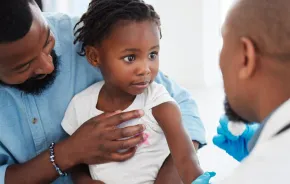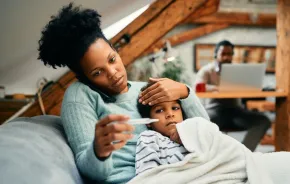
When Dani Parkman* was 9 or 10, he read Tamora Pierce’s young adult fantasy series The Song of the Lioness, which follows the heroine Alanna’s efforts to become a knight. Alanna trades places with her twin brother, disguises herself as a boy and successfully completes knight school.
Alanna’s adventures planted a seed in Dani’s subconscious. Born a girl, he wondered whether there was a knight school in Seattle for boys that he could attend in disguise. But unlike Alanna, who eventually reveals her deception, Dani wanted to become a boy and stay that way.
By the end of seventh grade, these subconscious thoughts rose to the surface. Over the summer, Dani’s parents noticed he had checked out books about transgender children and teens from the library. In January of his eighth-grade year, Dani left a note on his mother’s pillow written in multicolored ink. “LGBTQ (for questioning, rather than queer)” it read. By April of that year, he knew he could no longer live as a girl. He attended his eighth-grade graduation in a suit. That summer he and his family attended Gender Odyssey, an annual international conference in Seattle for gender-nonconforming people, and began attending support groups. He attended summer camp as a boy, trying out a new, nonambiguous male name, which he ultimately rejected.
There is growing awareness about kids like Dani, whose gender identities do not conform to the stereotypes of the genders they were born under. In a 2012 survey conducted by the Human Rights Campaign Foundation and Gender Spectrum, an Oakland, Calif.–based nonprofit dedicated to creating a gender-inclusive environment for all children and teens, 10,000 LGBT youth were asked about gender. Nearly 10 percent of them reported they did not identify as either male or female. One-third of the 10 percent identified as transgender and two-thirds identified as “other,” meaning they choose not to adhere to the Western, binary concept of gender expression, instead seeing themselves as falling somewhere on the spectrum between pink and blue.
In the fall, Dani started high school as a boy. He uses male pronouns, binds his breasts every day and takes hormone blockers to stop puberty. For now, he has opted not to change his name and wears his hair long.
Around Washington state, across the country and around the world, transgender, gender-nonconforming and gender-questioning kids and their families are treading new paths toward expression and acceptance. Schools, communities and governments are shifting from long-held assumptions to understand, and in some cases, accommodate a broader definition of gender. The movement is still young, but it is growing.
 Understanding gender
Understanding gender
“Ever since I was little I struggled with gender, though at the time, I didn’t realize that’s what I was struggling with,” says stand-up comedian and social justice activist Sam Killermann. “I’m a fairly androgynous person. I identify with a lot of what it means to be a man, as well as a woman. People attributed this to my sexuality, labeling me as ‘gay,’” says Killermann, who identifies as a heterosexual male. “It was only in college that I realized that the social friction I was experiencing had everything to do with my gender and little to nothing to do with my sexuality.”
Killermann developed It’s Pronounced Metrosexual, a comedy show and online resource about snap judgments, identity and oppression. He’s the author of The Social Justice Advocate’s Handbook: A Guide to Gender and the creator of The Genderbread Person, v2.0, an explanatory icon that illustrates gender identity, gender expression, biological sex, and romantic and sexual attraction as distinct human characteristics.
The Genderbread Person helped Dani Parkman’s parents, Marco and Erica Parkman*, broaden their understanding of gender and sexuality. “I am mindful of my own ignorance,” Marco Parkman says. “I realized I needed to learn something. There is no sharp line.”
What's in a label?
Last February, Facebook announced it would offer more than 50 options for users to identify their gender. This list ranges from “agender” to “cisgender” (identifying as the gender you were born as) and covers a broad spectrum in between that includes umbrella terms such as “non-binary,” “gender fluid,” “gender non-conforming,” “gender expansive” and “gender queer,” as well as “bi-gender,” “intersex,” “two-spirit” and “pangender.”
“Labels make us feel safe,” explains 17-year-old Mo Dole, a Bellingham high school student who began struggling to understand her feelings about gender after working on a school protest project about the gender binary for her AP English class. “I’m struggling with trying to find a label that fits me, or being OK if nothing does.”
 For parents, all this new terminology may seem bewildering and even limiting.
For parents, all this new terminology may seem bewildering and even limiting.
“When Dani first told me he wanted to be a boy, my first reaction was, ‘I know what this is about. I spent my entire childhood wanting to be a boy,’” says mom Erica Parkman. “Dani’s response was, ‘I’m not pretending. This is who I am.’”
“Gender was not a defining part of my life,” explains Parkman, who has her degree in math and a career in medicine. “I’ve always defied gender stereotypes. We live in a gender-nonconforming household. The thing I don’t understand, don’t expect to understand — and it doesn’t really matter whether I understand — is why he has to be ‘he.’”
Parkman acknowledges that Dani suffers huge discomfort with having a girl’s body and became much happier when taking hormone blockers. “The struggle here is about self,” says Parkman. “My sense of Dani’s gender identity is that it is a neurobiological thing. It’s just who he is.”
Similarly, Mo Dole’s mother, Deb Dole, who is in her early 50s, like Erica Parkman, wonders why her daughter needed to be defined by her gender. Dole presents as a non-stereotypical female in a two-parent household that, like Dani Parkman’s, is gender nonconforming. For example, Dole’s two daughters have her last name, rather than her husband’s.
“There are so many ways to be female,” Dole says of her daughter’s desire to identify as gender fluid. “Why not just create your own self?”
What is real and what is make-believe?
This past June, a video made by the Whittington family about their transgender son, Ryland, went viral on YouTube. Born a girl, Ryland unequivocally expressed that he was a boy from the time he could talk. Concerned by his growing depression and by the statistics that show the high suicide rates of transgender youths, the Whittington family decided to allow him to live as a boy. The Harvey Milk Foundation presented 6-year-old Ryland with its Inspiration Award for sharing his story.
The subsequent posting of his video has generated a new level of awareness about transgender and gender-nonconforming kids. For older kids who can express their feelings in words, parents may have an easier time understanding what is going on. But what about younger kids? How can parents tell if a little boy’s desire to dress up like a fairy princess or a girl’s wish to become a knight is something more than make-believe?
According to Gender Spectrum, a California-based gender support organization, most people have a sense of their gender identity between 2 and 4 years old. For some children, gender nonconformity is a phase, but for others it is not. The longer a child identifies as gender-nonconforming, the more stable this identity becomes, experts say. However, some children may change their minds at around 9 or 10. Gender identity becomes further refined at the onset of puberty.
Saying "yes" to the dress
When he was in preschool, Maria Johnson’s* son Casey* loved to play with girls and dress up in shimmery, glittery, colorful clothes. One summer, during a playdate with a friend, he wistfully wished for a skirt he could run around in. Something in his tone made Johnson believe her son had been thinking about this for a while. “I asked myself, ‘Why am I saying no to this?’” She bought Casey a skirt to bring on vacation, and it was the only item of clothing he wore.
That was a turning point.
After a gradual progression of boyish “school clothes” and girlish “home clothes,” Casey began dressing like a girl all the time.
“A lot of people thought it was cute,” recalls Johnson.
A shy, subdued child, Casey had been diagnosed with anxiety. His parents, well aware of the suicide rates among transgender youth, felt they had to honor his chosen means of expressing himself.
Looking back, Johnson says that for Casey, it was difficult to be in the “gray zone.” Because he naturally gravitated toward things considered “girly,” his mom believes he assumed that people would let him like those things if he pretended to be a girl.
“We respected what he asked for, but didn’t encourage. He was clearly trying to find himself,” she says. “[It is about] letting your kid take the lead,” says Pam Wool, director of family services and administration for Gender Spectrum. “Let them know they have options. “
Born a boy, 13-year-old Victoria says she knew subconsciously at age 3 that she was a girl but didn’t become aware of transgender people until a few months ago. When she came out, her mother, Carole Ann (mom and daughter requested that their last names not be used), wasn’t surprised. “She always presented as a girl,” Carole Ann says. “I always knew, but I didn’t want to encourage it.”
Like all of the kids profiled in this article, Victoria suffered from anxiety and depression. She says she contemplated suicide at age 5.
“Puberty scared me,” the teen says. “Life scared me.”
Once the family allowed Victoria to express herself as female, her mother says her anxiety decreased and her grades went up.
Victoria now dresses like a girl, has changed her name, uses female pronouns and will soon begin taking female hormones. On Instagram, she offers support to other transgender kids.
In contrast, Casey, now 9, appears to be gravitating toward a more “boyish” identity and recently has begun identifying himself as a boy, though he also has exhibited some new anxious tics.
His mother doesn’t know whether he feels pressured to be one gender or another. “He tried to be ambivalent for as long as possible. I wish there were more societal support for people who fall in the gray area,” says Johnson.
On the playground, in the classroom
Seattle Public Schools and some other districts have guidelines for the treatment of transgender students, while some districts still have none. Even when guidelines exist, implementation of support can differ from school to school.
As she grappled with how to ease Casey’s adjustment to kindergarten at a new Seattle school, Maria Johnson found herself stumped by a practical consideration — the bathroom. The kindergarten class Casey was assigned to had its own unisex bathroom, but the teacher still seemed uncomfortable with how to handle Casey’s situation, the family says. Another kindergarten teacher seemed at ease with Casey, but there wasn’t a bathroom in that classroom. The school accommodated Johnson’s request to move Casey into the other classroom, and the new teacher assigned Casey the job of collecting the classroom mail so that Casey could use the toilet in the nurse’s office. He also devised hand signals for Casey, in case the need arose at other times.
In contrast, when Victoria started sixth grade at a Seattle middle school, she was bullied. She decided to tell people she was gay, and when it became clear in seventh grade that the bullying, which now included death threats, was getting worse, Victoria transferred to a K–8 school with a more nurturing environment.
Some schools and districts have begun investing in the type of staff and student training that discourages bullying and promotes understanding. Pam Wool of Gender Spectrum says her organization invests considerable effort to work with schools and make gender a universally relatable topic.
“Everybody has a gender story, not just trans and gender-expansive kids. Gender norms and rules have affected us all positively and negatively,” Wool says.
Support is crucial
Dani has advice for kids contemplating coming out to their parents. “Expect the worst and hope for the best.” His advice to parents: “If you think you are going to react in an inflammatory way, go away and think, because your kid will take that as a hard blow.”
Victoria puts it in starker terms. “Ask yourself, would you rather have a dead son or a live daughter?”
Dani’s and Casey’s parents chose to send letters to family, friends and school communities alerting them to their decision to honor their child’s gender expression.
“I knew the information would come out,” says Johnson. “I decided I could either shape it and influence how people hear it and deal with it, or it was going to be gossip.”
All of the parents interviewed said having a gender-questioning child strengthened, rather than hurt, their marriages, and that their children’s depression was a far more distressing problem.
Attending gender conferences and support groups has helped.
“There is no instruction manual,” says Marco Parkman.
“Everybody has a gender story, not just trans and gender-expansive kids. Gender norms and rules have affected us all positively and negatively.”
— Pam Wool, Gender Spectrum
What the future holds
There is growing acknowledgement that being transgender is a normal variation of gender identity. In May 2013, the American Psychiatric Association replaced the term “gender identity disorder” with the term “gender dysphoria.” Transgender youths can be given reversible hormone blockers that suppress puberty, allowing time for greater self-awareness of gender, and cross-gender sex hormones can be taken later.
Hospitals such as Children’s Hospital Los Angeles and the children’s hospital at the University of California, San Francisco, offer multidisciplinary centers that focus on the health and development of transgender children and adolescents and also conduct research.
But perhaps the greatest strides that have been and have yet to be made are societal. “We have a term called gender identity, and that’s exciting,” says Aidan Key, gender specialist and facilitator for gender diversity support groups at Seattle Children’s.
Wool sees kids who identify as both genders or neither as representing the new frontier of gender expression.
Germany now offers a third gender option on birth certificates for intersexual babies. In a landmark decision, India’s Supreme Court has officially recognized transgender people. A gender-neutral pronoun has been added to the Swedish language.
There have been calls to add gender-neutral pronouns, such as “ze,” to the English language. These language changes are reminiscent of the early 1970s, when the title “Ms.” came into vogue. Many were skeptical that the term would stick. Now women are routinely addressed by a marriage-neutral title.
History is rife with examples of sweeping changes to longstanding conventions: women’s suffrage, the civil rights movement and, most recently, the growing acceptance of same-sex marriage. Advocates of gender diversity hope their time has come, too.











